Psychology, Biological and social influences of depression
VerifiedAdded on 2023/04/26
|11
|3309
|287
AI Summary
In this research report slide we will discuss about psychology and bleow are the summaries point:-
Depression is a serious mood disorder that affects an individual's ability to think, perceive, react, and handle daily life activities.
It is diagnosed when symptoms are present for at least two weeks.
Prevalence of depression is around 7.6% for people over the age of 12, and it is the major cause of disability globally.
Historical development of depression treatment includes lobotomies, electroconvulsive therapy, and the classification of depression into categories.
Biological, psychological, and social influences are factors leading to depression.
Biological influences refer to the improper functioning of the brain functions caused by neurotransmitters such as serotonin and norepinephrine.
Psychological influences refer to the way of perceiving things around the world developed in childhood, and professional burnout can cause depression.
Contribute Materials
Your contribution can guide someone’s learning journey. Share your
documents today.
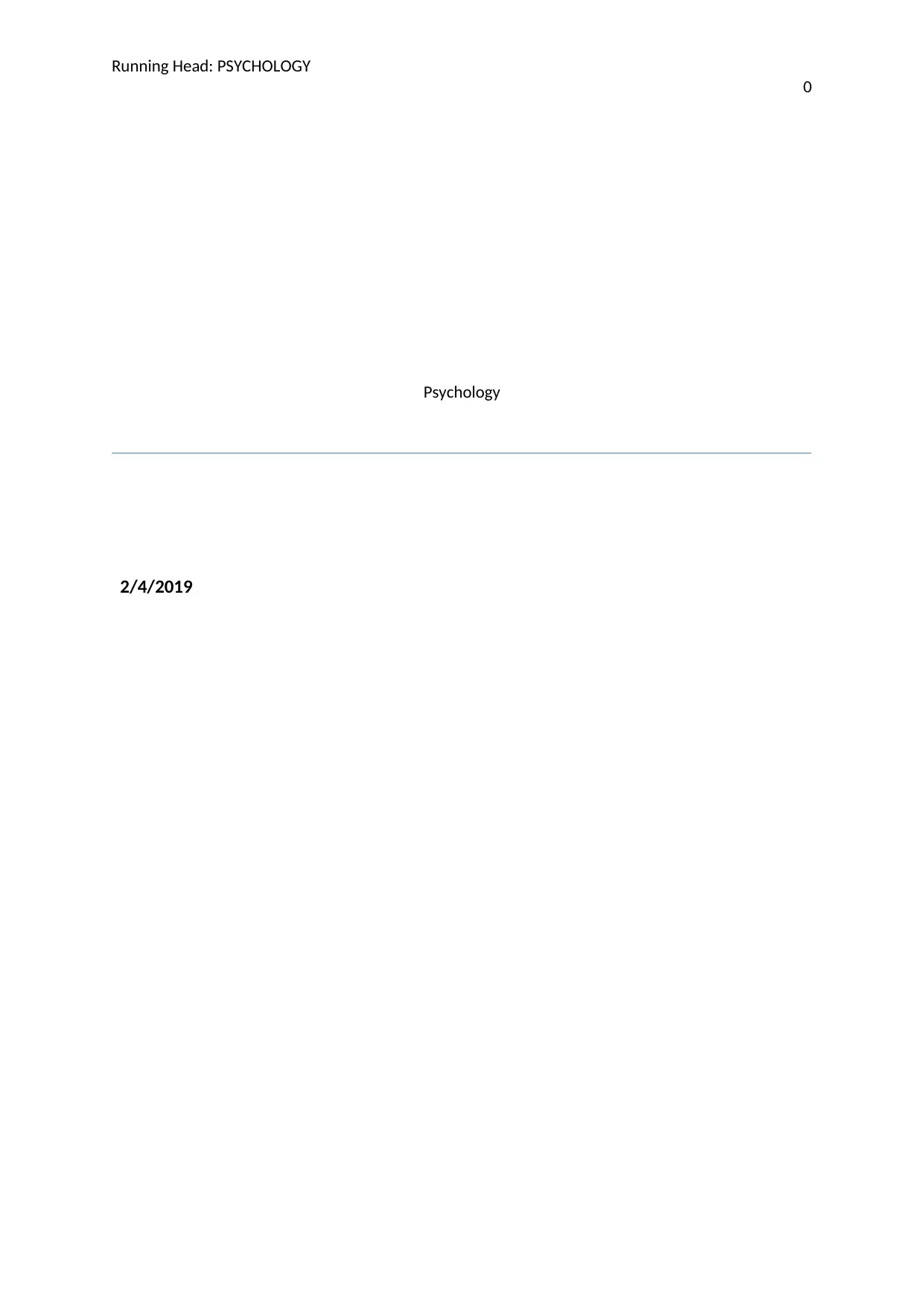
Running Head: PSYCHOLOGY
0
Psychology
2/4/2019
0
Psychology
2/4/2019
Secure Best Marks with AI Grader
Need help grading? Try our AI Grader for instant feedback on your assignments.
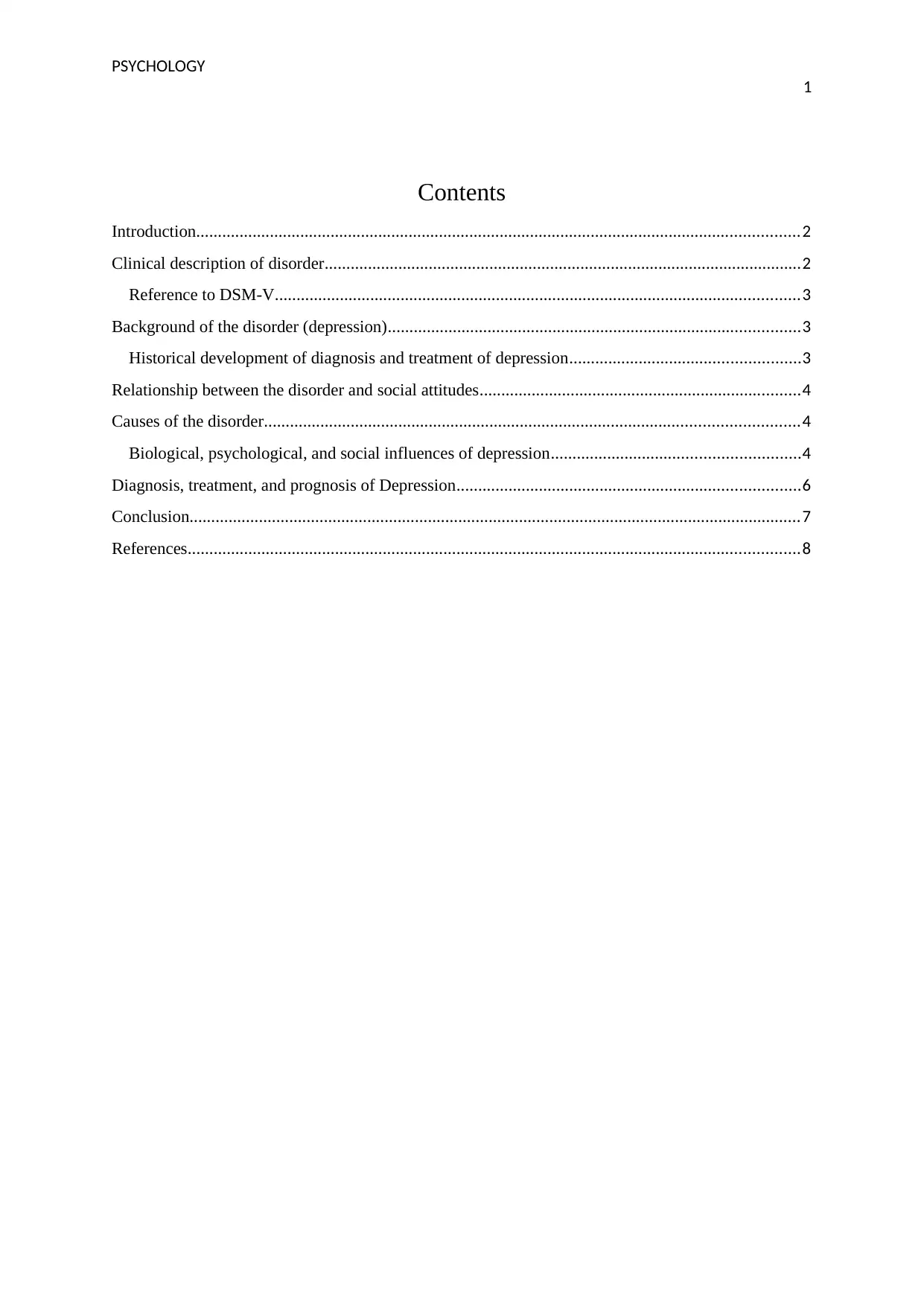
PSYCHOLOGY
1
Contents
Introduction...........................................................................................................................................2
Clinical description of disorder..............................................................................................................2
Reference to DSM-V.........................................................................................................................3
Background of the disorder (depression)...............................................................................................3
Historical development of diagnosis and treatment of depression.....................................................3
Relationship between the disorder and social attitudes..........................................................................4
Causes of the disorder...........................................................................................................................4
Biological, psychological, and social influences of depression.........................................................4
Diagnosis, treatment, and prognosis of Depression...............................................................................6
Conclusion.............................................................................................................................................7
References.............................................................................................................................................8
1
Contents
Introduction...........................................................................................................................................2
Clinical description of disorder..............................................................................................................2
Reference to DSM-V.........................................................................................................................3
Background of the disorder (depression)...............................................................................................3
Historical development of diagnosis and treatment of depression.....................................................3
Relationship between the disorder and social attitudes..........................................................................4
Causes of the disorder...........................................................................................................................4
Biological, psychological, and social influences of depression.........................................................4
Diagnosis, treatment, and prognosis of Depression...............................................................................6
Conclusion.............................................................................................................................................7
References.............................................................................................................................................8
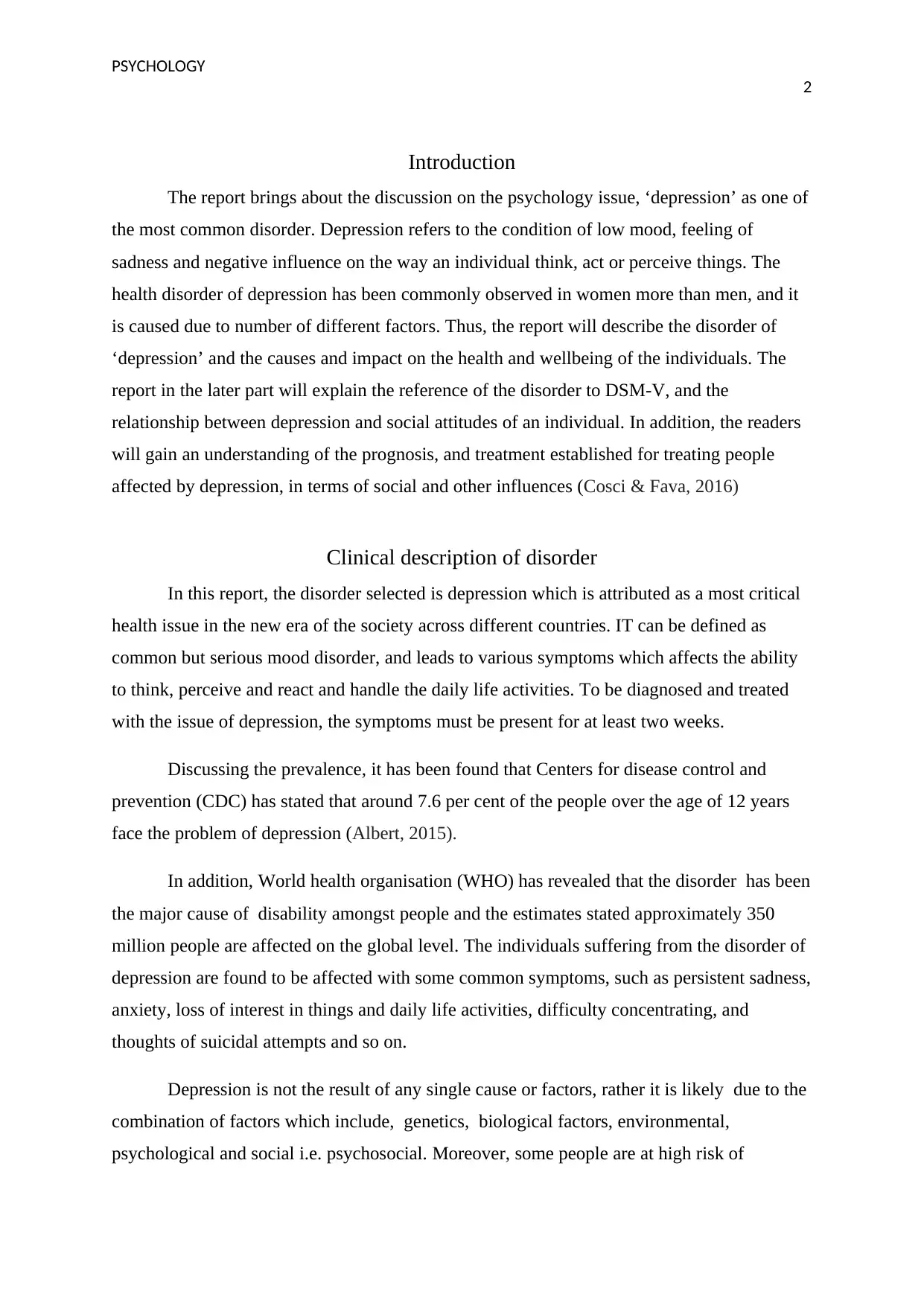
PSYCHOLOGY
2
Introduction
The report brings about the discussion on the psychology issue, ‘depression’ as one of
the most common disorder. Depression refers to the condition of low mood, feeling of
sadness and negative influence on the way an individual think, act or perceive things. The
health disorder of depression has been commonly observed in women more than men, and it
is caused due to number of different factors. Thus, the report will describe the disorder of
‘depression’ and the causes and impact on the health and wellbeing of the individuals. The
report in the later part will explain the reference of the disorder to DSM-V, and the
relationship between depression and social attitudes of an individual. In addition, the readers
will gain an understanding of the prognosis, and treatment established for treating people
affected by depression, in terms of social and other influences (Cosci & Fava, 2016)
Clinical description of disorder
In this report, the disorder selected is depression which is attributed as a most critical
health issue in the new era of the society across different countries. IT can be defined as
common but serious mood disorder, and leads to various symptoms which affects the ability
to think, perceive and react and handle the daily life activities. To be diagnosed and treated
with the issue of depression, the symptoms must be present for at least two weeks.
Discussing the prevalence, it has been found that Centers for disease control and
prevention (CDC) has stated that around 7.6 per cent of the people over the age of 12 years
face the problem of depression (Albert, 2015).
In addition, World health organisation (WHO) has revealed that the disorder has been
the major cause of disability amongst people and the estimates stated approximately 350
million people are affected on the global level. The individuals suffering from the disorder of
depression are found to be affected with some common symptoms, such as persistent sadness,
anxiety, loss of interest in things and daily life activities, difficulty concentrating, and
thoughts of suicidal attempts and so on.
Depression is not the result of any single cause or factors, rather it is likely due to the
combination of factors which include, genetics, biological factors, environmental,
psychological and social i.e. psychosocial. Moreover, some people are at high risk of
2
Introduction
The report brings about the discussion on the psychology issue, ‘depression’ as one of
the most common disorder. Depression refers to the condition of low mood, feeling of
sadness and negative influence on the way an individual think, act or perceive things. The
health disorder of depression has been commonly observed in women more than men, and it
is caused due to number of different factors. Thus, the report will describe the disorder of
‘depression’ and the causes and impact on the health and wellbeing of the individuals. The
report in the later part will explain the reference of the disorder to DSM-V, and the
relationship between depression and social attitudes of an individual. In addition, the readers
will gain an understanding of the prognosis, and treatment established for treating people
affected by depression, in terms of social and other influences (Cosci & Fava, 2016)
Clinical description of disorder
In this report, the disorder selected is depression which is attributed as a most critical
health issue in the new era of the society across different countries. IT can be defined as
common but serious mood disorder, and leads to various symptoms which affects the ability
to think, perceive and react and handle the daily life activities. To be diagnosed and treated
with the issue of depression, the symptoms must be present for at least two weeks.
Discussing the prevalence, it has been found that Centers for disease control and
prevention (CDC) has stated that around 7.6 per cent of the people over the age of 12 years
face the problem of depression (Albert, 2015).
In addition, World health organisation (WHO) has revealed that the disorder has been
the major cause of disability amongst people and the estimates stated approximately 350
million people are affected on the global level. The individuals suffering from the disorder of
depression are found to be affected with some common symptoms, such as persistent sadness,
anxiety, loss of interest in things and daily life activities, difficulty concentrating, and
thoughts of suicidal attempts and so on.
Depression is not the result of any single cause or factors, rather it is likely due to the
combination of factors which include, genetics, biological factors, environmental,
psychological and social i.e. psychosocial. Moreover, some people are at high risk of
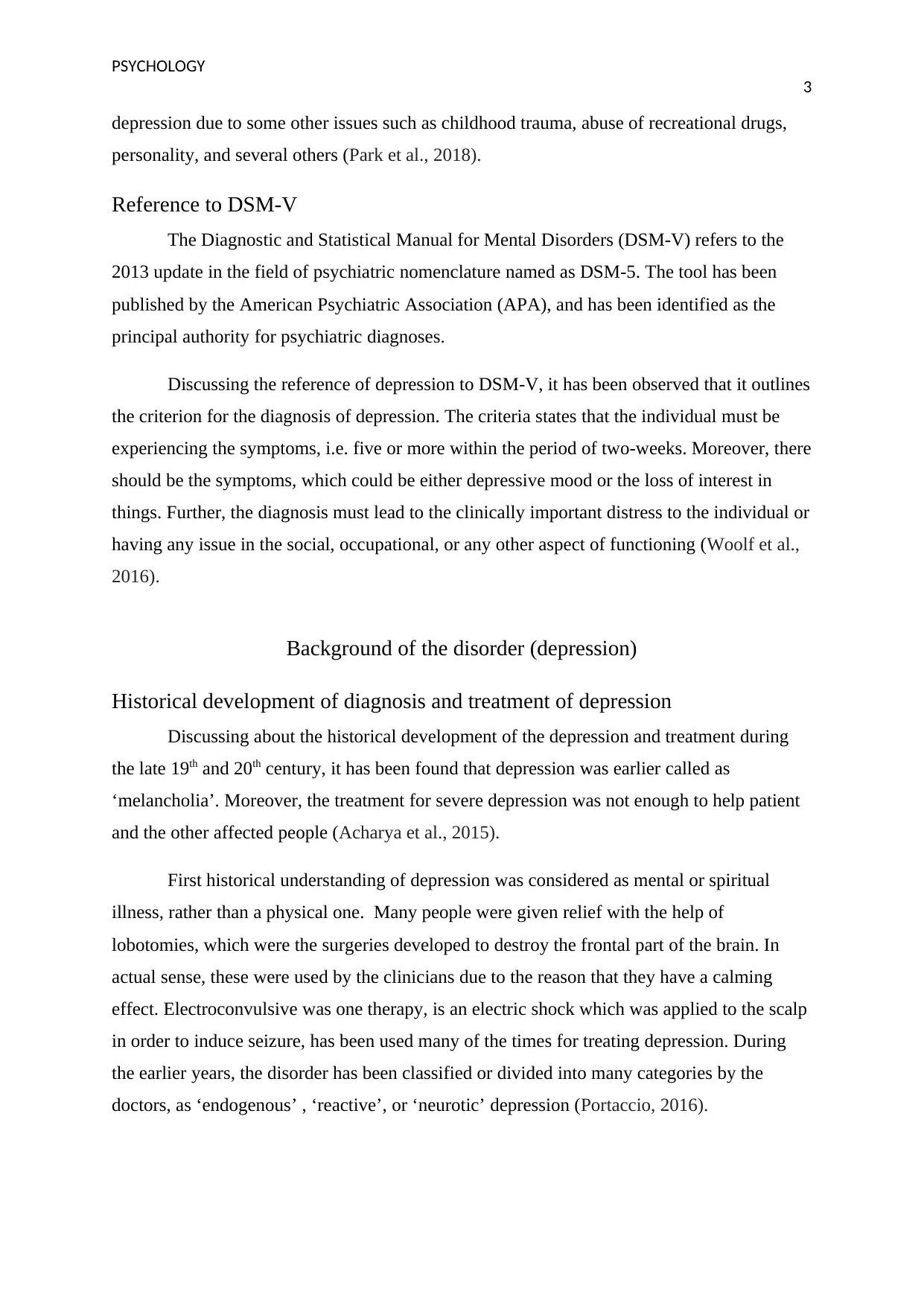
PSYCHOLOGY
3
depression due to some other issues such as childhood trauma, abuse of recreational drugs,
personality, and several others (Park et al., 2018).
Reference to DSM-V
The Diagnostic and Statistical Manual for Mental Disorders (DSM-V) refers to the
2013 update in the field of psychiatric nomenclature named as DSM-5. The tool has been
published by the American Psychiatric Association (APA), and has been identified as the
principal authority for psychiatric diagnoses.
Discussing the reference of depression to DSM-V, it has been observed that it outlines
the criterion for the diagnosis of depression. The criteria states that the individual must be
experiencing the symptoms, i.e. five or more within the period of two-weeks. Moreover, there
should be the symptoms, which could be either depressive mood or the loss of interest in
things. Further, the diagnosis must lead to the clinically important distress to the individual or
having any issue in the social, occupational, or any other aspect of functioning (Woolf et al.,
2016).
Background of the disorder (depression)
Historical development of diagnosis and treatment of depression
Discussing about the historical development of the depression and treatment during
the late 19th and 20th century, it has been found that depression was earlier called as
‘melancholia’. Moreover, the treatment for severe depression was not enough to help patient
and the other affected people (Acharya et al., 2015).
First historical understanding of depression was considered as mental or spiritual
illness, rather than a physical one. Many people were given relief with the help of
lobotomies, which were the surgeries developed to destroy the frontal part of the brain. In
actual sense, these were used by the clinicians due to the reason that they have a calming
effect. Electroconvulsive was one therapy, is an electric shock which was applied to the scalp
in order to induce seizure, has been used many of the times for treating depression. During
the earlier years, the disorder has been classified or divided into many categories by the
doctors, as ‘endogenous’ , ‘reactive’, or ‘neurotic’ depression (Portaccio, 2016).
3
depression due to some other issues such as childhood trauma, abuse of recreational drugs,
personality, and several others (Park et al., 2018).
Reference to DSM-V
The Diagnostic and Statistical Manual for Mental Disorders (DSM-V) refers to the
2013 update in the field of psychiatric nomenclature named as DSM-5. The tool has been
published by the American Psychiatric Association (APA), and has been identified as the
principal authority for psychiatric diagnoses.
Discussing the reference of depression to DSM-V, it has been observed that it outlines
the criterion for the diagnosis of depression. The criteria states that the individual must be
experiencing the symptoms, i.e. five or more within the period of two-weeks. Moreover, there
should be the symptoms, which could be either depressive mood or the loss of interest in
things. Further, the diagnosis must lead to the clinically important distress to the individual or
having any issue in the social, occupational, or any other aspect of functioning (Woolf et al.,
2016).
Background of the disorder (depression)
Historical development of diagnosis and treatment of depression
Discussing about the historical development of the depression and treatment during
the late 19th and 20th century, it has been found that depression was earlier called as
‘melancholia’. Moreover, the treatment for severe depression was not enough to help patient
and the other affected people (Acharya et al., 2015).
First historical understanding of depression was considered as mental or spiritual
illness, rather than a physical one. Many people were given relief with the help of
lobotomies, which were the surgeries developed to destroy the frontal part of the brain. In
actual sense, these were used by the clinicians due to the reason that they have a calming
effect. Electroconvulsive was one therapy, is an electric shock which was applied to the scalp
in order to induce seizure, has been used many of the times for treating depression. During
the earlier years, the disorder has been classified or divided into many categories by the
doctors, as ‘endogenous’ , ‘reactive’, or ‘neurotic’ depression (Portaccio, 2016).
Secure Best Marks with AI Grader
Need help grading? Try our AI Grader for instant feedback on your assignments.
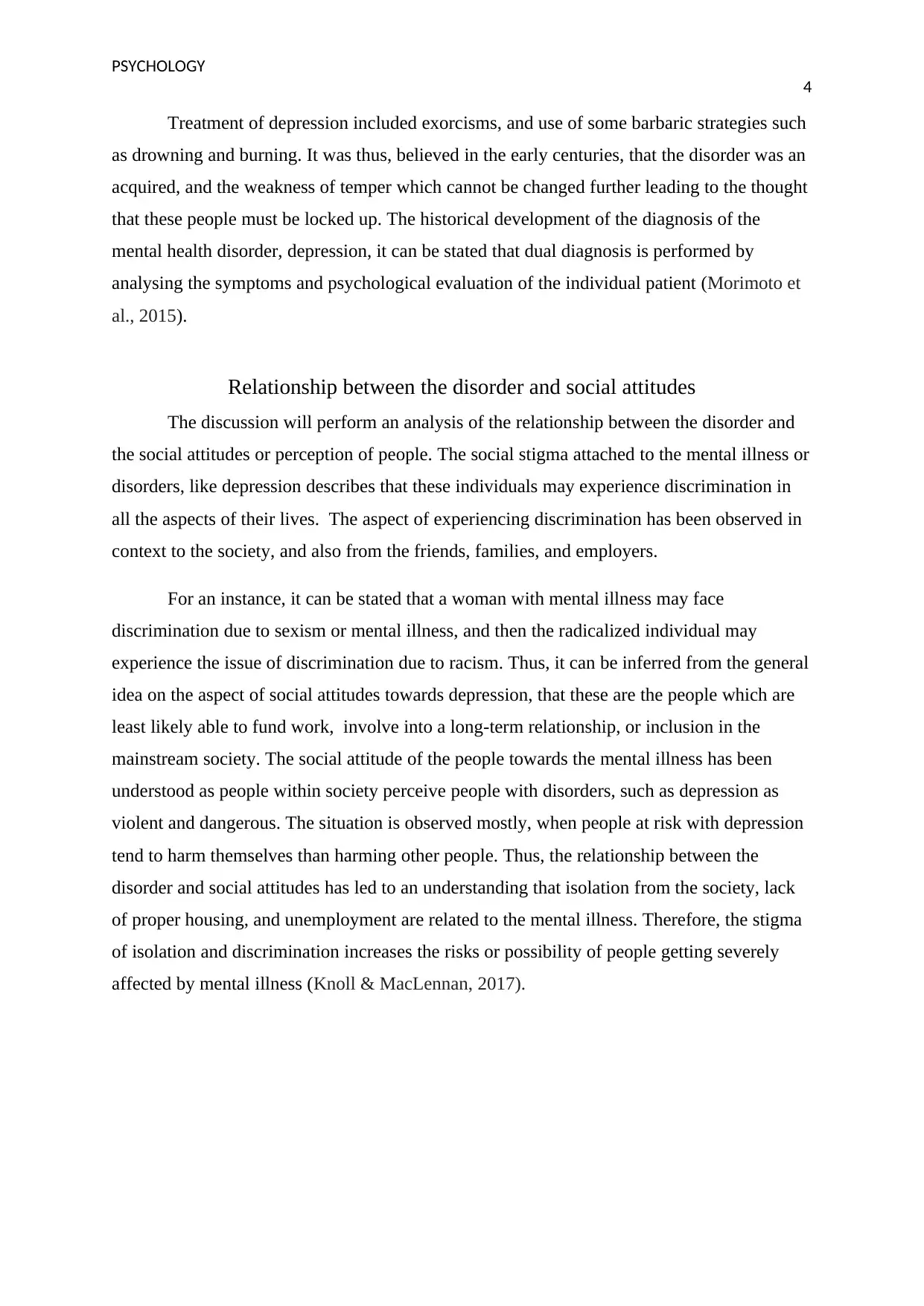
PSYCHOLOGY
4
Treatment of depression included exorcisms, and use of some barbaric strategies such
as drowning and burning. It was thus, believed in the early centuries, that the disorder was an
acquired, and the weakness of temper which cannot be changed further leading to the thought
that these people must be locked up. The historical development of the diagnosis of the
mental health disorder, depression, it can be stated that dual diagnosis is performed by
analysing the symptoms and psychological evaluation of the individual patient (Morimoto et
al., 2015).
Relationship between the disorder and social attitudes
The discussion will perform an analysis of the relationship between the disorder and
the social attitudes or perception of people. The social stigma attached to the mental illness or
disorders, like depression describes that these individuals may experience discrimination in
all the aspects of their lives. The aspect of experiencing discrimination has been observed in
context to the society, and also from the friends, families, and employers.
For an instance, it can be stated that a woman with mental illness may face
discrimination due to sexism or mental illness, and then the radicalized individual may
experience the issue of discrimination due to racism. Thus, it can be inferred from the general
idea on the aspect of social attitudes towards depression, that these are the people which are
least likely able to fund work, involve into a long-term relationship, or inclusion in the
mainstream society. The social attitude of the people towards the mental illness has been
understood as people within society perceive people with disorders, such as depression as
violent and dangerous. The situation is observed mostly, when people at risk with depression
tend to harm themselves than harming other people. Thus, the relationship between the
disorder and social attitudes has led to an understanding that isolation from the society, lack
of proper housing, and unemployment are related to the mental illness. Therefore, the stigma
of isolation and discrimination increases the risks or possibility of people getting severely
affected by mental illness (Knoll & MacLennan, 2017).
4
Treatment of depression included exorcisms, and use of some barbaric strategies such
as drowning and burning. It was thus, believed in the early centuries, that the disorder was an
acquired, and the weakness of temper which cannot be changed further leading to the thought
that these people must be locked up. The historical development of the diagnosis of the
mental health disorder, depression, it can be stated that dual diagnosis is performed by
analysing the symptoms and psychological evaluation of the individual patient (Morimoto et
al., 2015).
Relationship between the disorder and social attitudes
The discussion will perform an analysis of the relationship between the disorder and
the social attitudes or perception of people. The social stigma attached to the mental illness or
disorders, like depression describes that these individuals may experience discrimination in
all the aspects of their lives. The aspect of experiencing discrimination has been observed in
context to the society, and also from the friends, families, and employers.
For an instance, it can be stated that a woman with mental illness may face
discrimination due to sexism or mental illness, and then the radicalized individual may
experience the issue of discrimination due to racism. Thus, it can be inferred from the general
idea on the aspect of social attitudes towards depression, that these are the people which are
least likely able to fund work, involve into a long-term relationship, or inclusion in the
mainstream society. The social attitude of the people towards the mental illness has been
understood as people within society perceive people with disorders, such as depression as
violent and dangerous. The situation is observed mostly, when people at risk with depression
tend to harm themselves than harming other people. Thus, the relationship between the
disorder and social attitudes has led to an understanding that isolation from the society, lack
of proper housing, and unemployment are related to the mental illness. Therefore, the stigma
of isolation and discrimination increases the risks or possibility of people getting severely
affected by mental illness (Knoll & MacLennan, 2017).
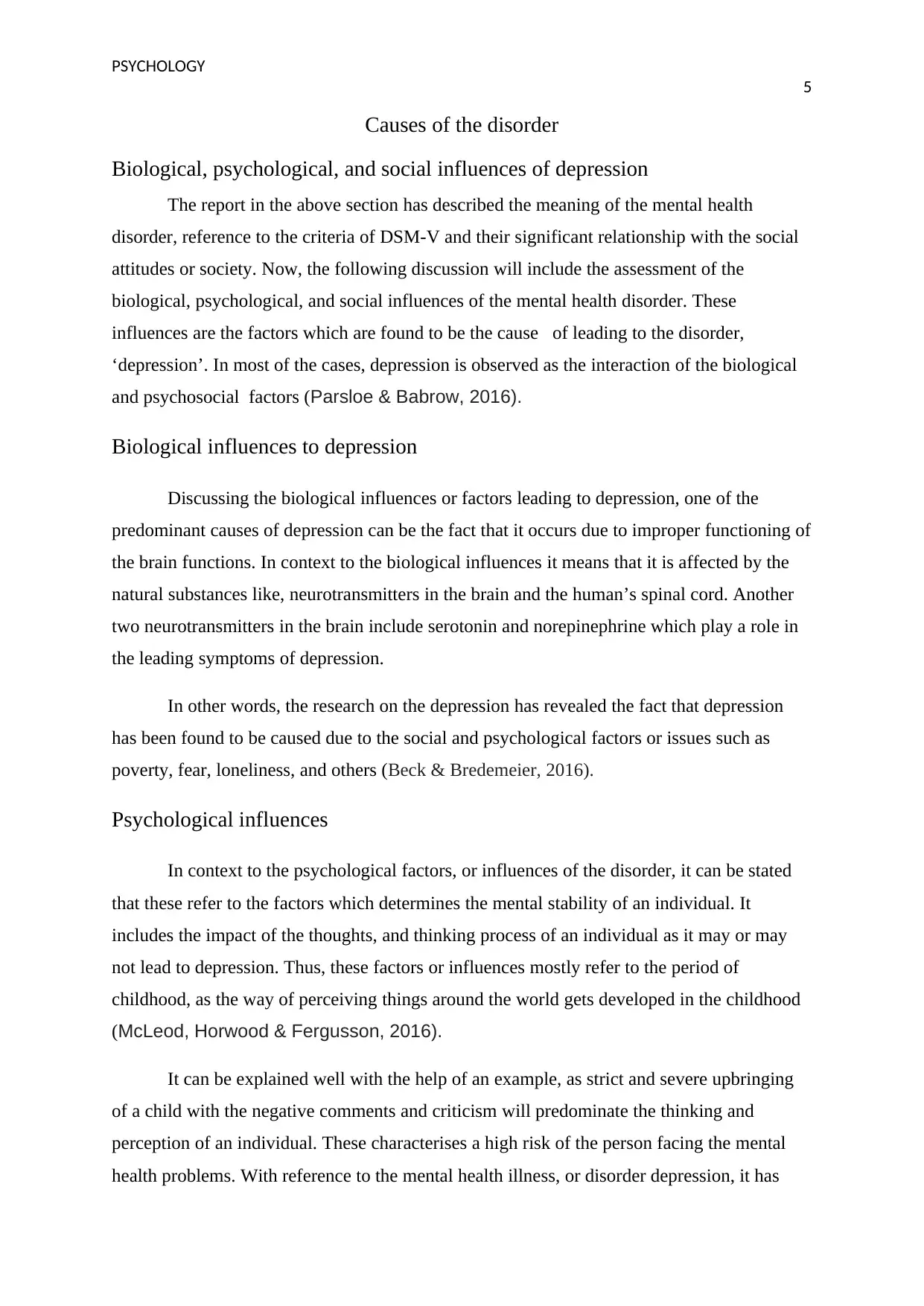
PSYCHOLOGY
5
Causes of the disorder
Biological, psychological, and social influences of depression
The report in the above section has described the meaning of the mental health
disorder, reference to the criteria of DSM-V and their significant relationship with the social
attitudes or society. Now, the following discussion will include the assessment of the
biological, psychological, and social influences of the mental health disorder. These
influences are the factors which are found to be the cause of leading to the disorder,
‘depression’. In most of the cases, depression is observed as the interaction of the biological
and psychosocial factors (Parsloe & Babrow, 2016).
Biological influences to depression
Discussing the biological influences or factors leading to depression, one of the
predominant causes of depression can be the fact that it occurs due to improper functioning of
the brain functions. In context to the biological influences it means that it is affected by the
natural substances like, neurotransmitters in the brain and the human’s spinal cord. Another
two neurotransmitters in the brain include serotonin and norepinephrine which play a role in
the leading symptoms of depression.
In other words, the research on the depression has revealed the fact that depression
has been found to be caused due to the social and psychological factors or issues such as
poverty, fear, loneliness, and others (Beck & Bredemeier, 2016).
Psychological influences
In context to the psychological factors, or influences of the disorder, it can be stated
that these refer to the factors which determines the mental stability of an individual. It
includes the impact of the thoughts, and thinking process of an individual as it may or may
not lead to depression. Thus, these factors or influences mostly refer to the period of
childhood, as the way of perceiving things around the world gets developed in the childhood
(McLeod, Horwood & Fergusson, 2016).
It can be explained well with the help of an example, as strict and severe upbringing
of a child with the negative comments and criticism will predominate the thinking and
perception of an individual. These characterises a high risk of the person facing the mental
health problems. With reference to the mental health illness, or disorder depression, it has
5
Causes of the disorder
Biological, psychological, and social influences of depression
The report in the above section has described the meaning of the mental health
disorder, reference to the criteria of DSM-V and their significant relationship with the social
attitudes or society. Now, the following discussion will include the assessment of the
biological, psychological, and social influences of the mental health disorder. These
influences are the factors which are found to be the cause of leading to the disorder,
‘depression’. In most of the cases, depression is observed as the interaction of the biological
and psychosocial factors (Parsloe & Babrow, 2016).
Biological influences to depression
Discussing the biological influences or factors leading to depression, one of the
predominant causes of depression can be the fact that it occurs due to improper functioning of
the brain functions. In context to the biological influences it means that it is affected by the
natural substances like, neurotransmitters in the brain and the human’s spinal cord. Another
two neurotransmitters in the brain include serotonin and norepinephrine which play a role in
the leading symptoms of depression.
In other words, the research on the depression has revealed the fact that depression
has been found to be caused due to the social and psychological factors or issues such as
poverty, fear, loneliness, and others (Beck & Bredemeier, 2016).
Psychological influences
In context to the psychological factors, or influences of the disorder, it can be stated
that these refer to the factors which determines the mental stability of an individual. It
includes the impact of the thoughts, and thinking process of an individual as it may or may
not lead to depression. Thus, these factors or influences mostly refer to the period of
childhood, as the way of perceiving things around the world gets developed in the childhood
(McLeod, Horwood & Fergusson, 2016).
It can be explained well with the help of an example, as strict and severe upbringing
of a child with the negative comments and criticism will predominate the thinking and
perception of an individual. These characterises a high risk of the person facing the mental
health problems. With reference to the mental health illness, or disorder depression, it has
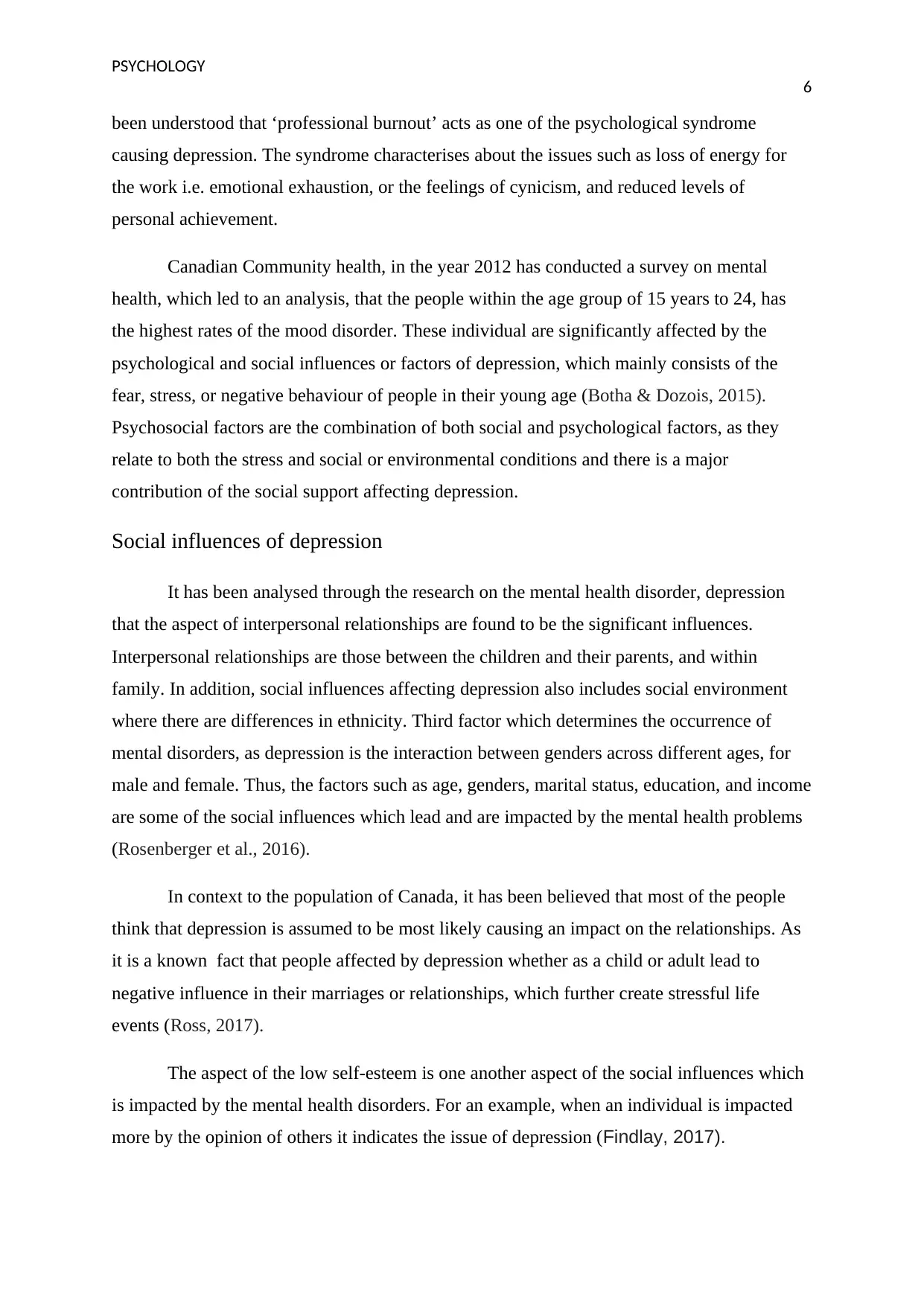
PSYCHOLOGY
6
been understood that ‘professional burnout’ acts as one of the psychological syndrome
causing depression. The syndrome characterises about the issues such as loss of energy for
the work i.e. emotional exhaustion, or the feelings of cynicism, and reduced levels of
personal achievement.
Canadian Community health, in the year 2012 has conducted a survey on mental
health, which led to an analysis, that the people within the age group of 15 years to 24, has
the highest rates of the mood disorder. These individual are significantly affected by the
psychological and social influences or factors of depression, which mainly consists of the
fear, stress, or negative behaviour of people in their young age (Botha & Dozois, 2015).
Psychosocial factors are the combination of both social and psychological factors, as they
relate to both the stress and social or environmental conditions and there is a major
contribution of the social support affecting depression.
Social influences of depression
It has been analysed through the research on the mental health disorder, depression
that the aspect of interpersonal relationships are found to be the significant influences.
Interpersonal relationships are those between the children and their parents, and within
family. In addition, social influences affecting depression also includes social environment
where there are differences in ethnicity. Third factor which determines the occurrence of
mental disorders, as depression is the interaction between genders across different ages, for
male and female. Thus, the factors such as age, genders, marital status, education, and income
are some of the social influences which lead and are impacted by the mental health problems
(Rosenberger et al., 2016).
In context to the population of Canada, it has been believed that most of the people
think that depression is assumed to be most likely causing an impact on the relationships. As
it is a known fact that people affected by depression whether as a child or adult lead to
negative influence in their marriages or relationships, which further create stressful life
events (Ross, 2017).
The aspect of the low self-esteem is one another aspect of the social influences which
is impacted by the mental health disorders. For an example, when an individual is impacted
more by the opinion of others it indicates the issue of depression (Findlay, 2017).
6
been understood that ‘professional burnout’ acts as one of the psychological syndrome
causing depression. The syndrome characterises about the issues such as loss of energy for
the work i.e. emotional exhaustion, or the feelings of cynicism, and reduced levels of
personal achievement.
Canadian Community health, in the year 2012 has conducted a survey on mental
health, which led to an analysis, that the people within the age group of 15 years to 24, has
the highest rates of the mood disorder. These individual are significantly affected by the
psychological and social influences or factors of depression, which mainly consists of the
fear, stress, or negative behaviour of people in their young age (Botha & Dozois, 2015).
Psychosocial factors are the combination of both social and psychological factors, as they
relate to both the stress and social or environmental conditions and there is a major
contribution of the social support affecting depression.
Social influences of depression
It has been analysed through the research on the mental health disorder, depression
that the aspect of interpersonal relationships are found to be the significant influences.
Interpersonal relationships are those between the children and their parents, and within
family. In addition, social influences affecting depression also includes social environment
where there are differences in ethnicity. Third factor which determines the occurrence of
mental disorders, as depression is the interaction between genders across different ages, for
male and female. Thus, the factors such as age, genders, marital status, education, and income
are some of the social influences which lead and are impacted by the mental health problems
(Rosenberger et al., 2016).
In context to the population of Canada, it has been believed that most of the people
think that depression is assumed to be most likely causing an impact on the relationships. As
it is a known fact that people affected by depression whether as a child or adult lead to
negative influence in their marriages or relationships, which further create stressful life
events (Ross, 2017).
The aspect of the low self-esteem is one another aspect of the social influences which
is impacted by the mental health disorders. For an example, when an individual is impacted
more by the opinion of others it indicates the issue of depression (Findlay, 2017).
Paraphrase This Document
Need a fresh take? Get an instant paraphrase of this document with our AI Paraphraser
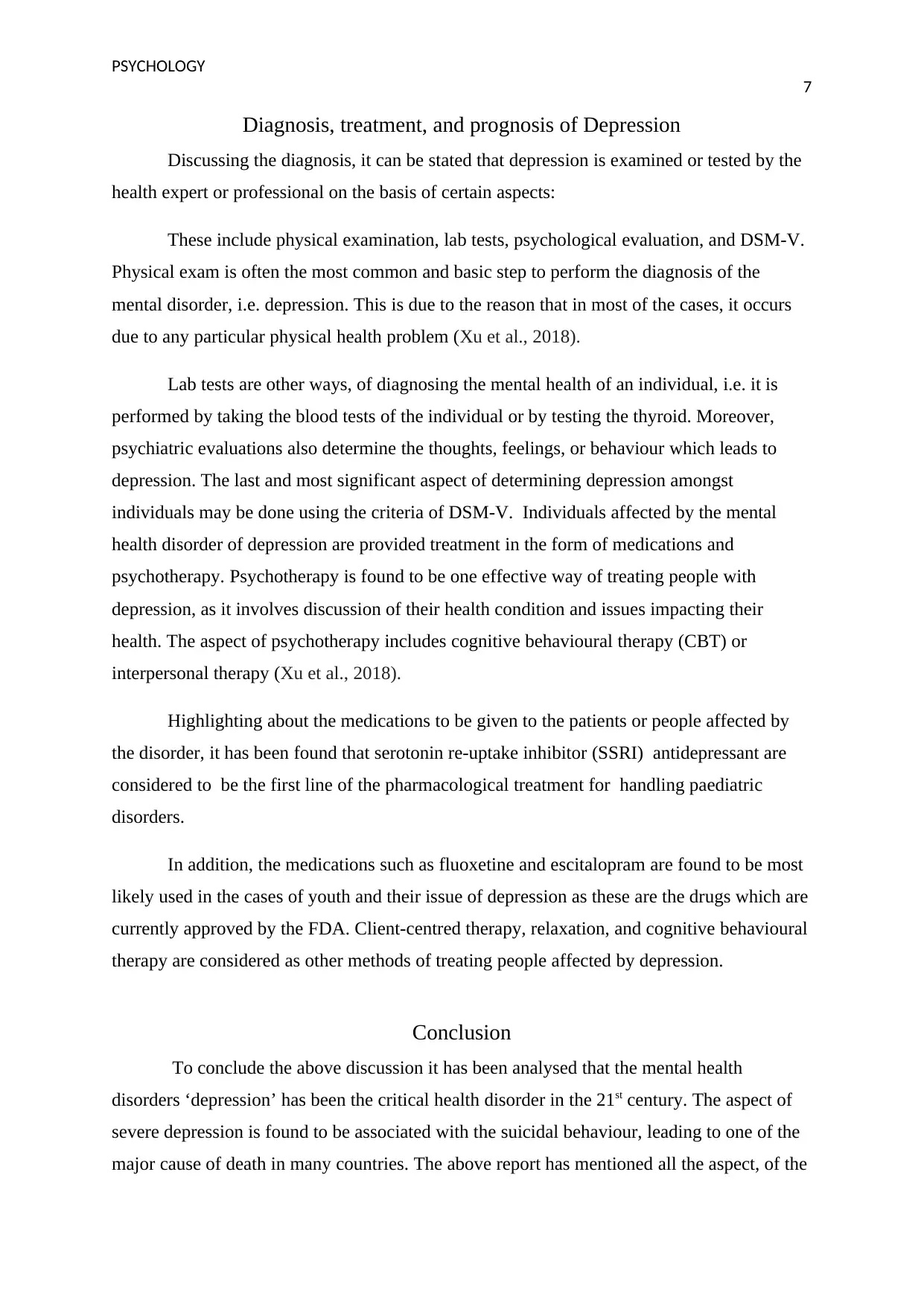
PSYCHOLOGY
7
Diagnosis, treatment, and prognosis of Depression
Discussing the diagnosis, it can be stated that depression is examined or tested by the
health expert or professional on the basis of certain aspects:
These include physical examination, lab tests, psychological evaluation, and DSM-V.
Physical exam is often the most common and basic step to perform the diagnosis of the
mental disorder, i.e. depression. This is due to the reason that in most of the cases, it occurs
due to any particular physical health problem (Xu et al., 2018).
Lab tests are other ways, of diagnosing the mental health of an individual, i.e. it is
performed by taking the blood tests of the individual or by testing the thyroid. Moreover,
psychiatric evaluations also determine the thoughts, feelings, or behaviour which leads to
depression. The last and most significant aspect of determining depression amongst
individuals may be done using the criteria of DSM-V. Individuals affected by the mental
health disorder of depression are provided treatment in the form of medications and
psychotherapy. Psychotherapy is found to be one effective way of treating people with
depression, as it involves discussion of their health condition and issues impacting their
health. The aspect of psychotherapy includes cognitive behavioural therapy (CBT) or
interpersonal therapy (Xu et al., 2018).
Highlighting about the medications to be given to the patients or people affected by
the disorder, it has been found that serotonin re-uptake inhibitor (SSRI) antidepressant are
considered to be the first line of the pharmacological treatment for handling paediatric
disorders.
In addition, the medications such as fluoxetine and escitalopram are found to be most
likely used in the cases of youth and their issue of depression as these are the drugs which are
currently approved by the FDA. Client-centred therapy, relaxation, and cognitive behavioural
therapy are considered as other methods of treating people affected by depression.
Conclusion
To conclude the above discussion it has been analysed that the mental health
disorders ‘depression’ has been the critical health disorder in the 21st century. The aspect of
severe depression is found to be associated with the suicidal behaviour, leading to one of the
major cause of death in many countries. The above report has mentioned all the aspect, of the
7
Diagnosis, treatment, and prognosis of Depression
Discussing the diagnosis, it can be stated that depression is examined or tested by the
health expert or professional on the basis of certain aspects:
These include physical examination, lab tests, psychological evaluation, and DSM-V.
Physical exam is often the most common and basic step to perform the diagnosis of the
mental disorder, i.e. depression. This is due to the reason that in most of the cases, it occurs
due to any particular physical health problem (Xu et al., 2018).
Lab tests are other ways, of diagnosing the mental health of an individual, i.e. it is
performed by taking the blood tests of the individual or by testing the thyroid. Moreover,
psychiatric evaluations also determine the thoughts, feelings, or behaviour which leads to
depression. The last and most significant aspect of determining depression amongst
individuals may be done using the criteria of DSM-V. Individuals affected by the mental
health disorder of depression are provided treatment in the form of medications and
psychotherapy. Psychotherapy is found to be one effective way of treating people with
depression, as it involves discussion of their health condition and issues impacting their
health. The aspect of psychotherapy includes cognitive behavioural therapy (CBT) or
interpersonal therapy (Xu et al., 2018).
Highlighting about the medications to be given to the patients or people affected by
the disorder, it has been found that serotonin re-uptake inhibitor (SSRI) antidepressant are
considered to be the first line of the pharmacological treatment for handling paediatric
disorders.
In addition, the medications such as fluoxetine and escitalopram are found to be most
likely used in the cases of youth and their issue of depression as these are the drugs which are
currently approved by the FDA. Client-centred therapy, relaxation, and cognitive behavioural
therapy are considered as other methods of treating people affected by depression.
Conclusion
To conclude the above discussion it has been analysed that the mental health
disorders ‘depression’ has been the critical health disorder in the 21st century. The aspect of
severe depression is found to be associated with the suicidal behaviour, leading to one of the
major cause of death in many countries. The above report has mentioned all the aspect, of the
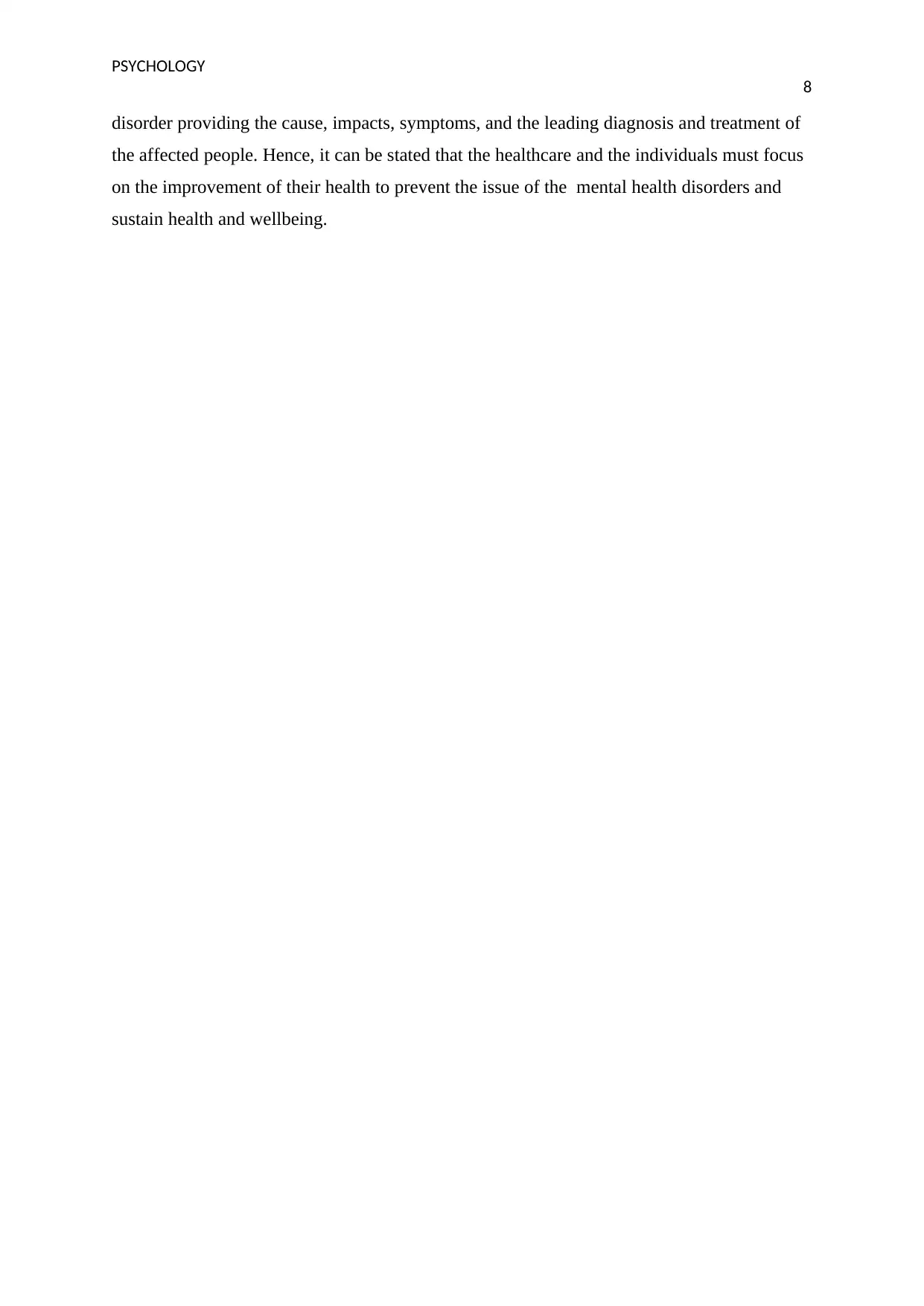
PSYCHOLOGY
8
disorder providing the cause, impacts, symptoms, and the leading diagnosis and treatment of
the affected people. Hence, it can be stated that the healthcare and the individuals must focus
on the improvement of their health to prevent the issue of the mental health disorders and
sustain health and wellbeing.
8
disorder providing the cause, impacts, symptoms, and the leading diagnosis and treatment of
the affected people. Hence, it can be stated that the healthcare and the individuals must focus
on the improvement of their health to prevent the issue of the mental health disorders and
sustain health and wellbeing.
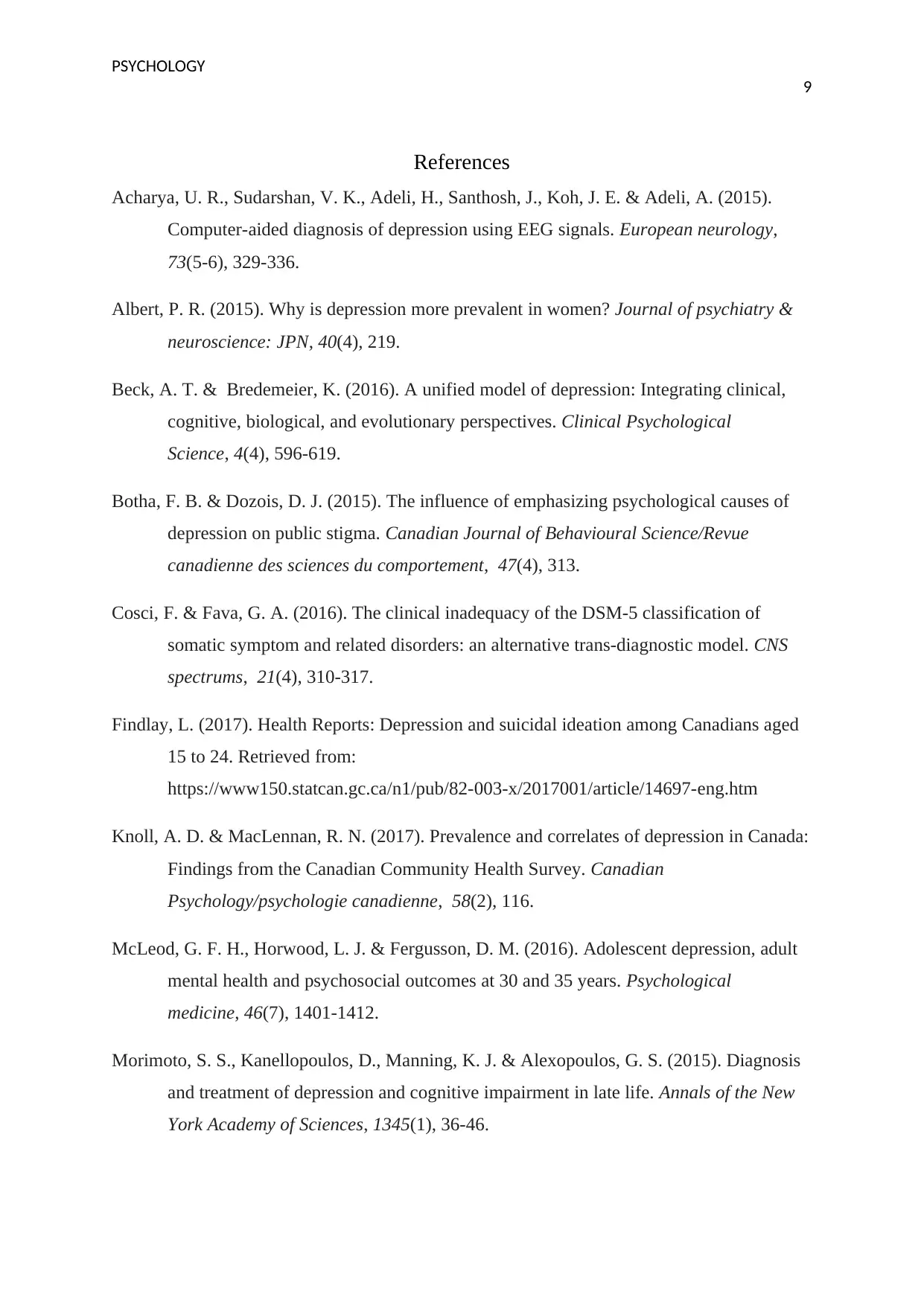
PSYCHOLOGY
9
References
Acharya, U. R., Sudarshan, V. K., Adeli, H., Santhosh, J., Koh, J. E. & Adeli, A. (2015).
Computer-aided diagnosis of depression using EEG signals. European neurology,
73(5-6), 329-336.
Albert, P. R. (2015). Why is depression more prevalent in women? Journal of psychiatry &
neuroscience: JPN, 40(4), 219.
Beck, A. T. & Bredemeier, K. (2016). A unified model of depression: Integrating clinical,
cognitive, biological, and evolutionary perspectives. Clinical Psychological
Science, 4(4), 596-619.
Botha, F. B. & Dozois, D. J. (2015). The influence of emphasizing psychological causes of
depression on public stigma. Canadian Journal of Behavioural Science/Revue
canadienne des sciences du comportement, 47(4), 313.
Cosci, F. & Fava, G. A. (2016). The clinical inadequacy of the DSM-5 classification of
somatic symptom and related disorders: an alternative trans-diagnostic model. CNS
spectrums, 21(4), 310-317.
Findlay, L. (2017). Health Reports: Depression and suicidal ideation among Canadians aged
15 to 24. Retrieved from:
https://www150.statcan.gc.ca/n1/pub/82-003-x/2017001/article/14697-eng.htm
Knoll, A. D. & MacLennan, R. N. (2017). Prevalence and correlates of depression in Canada:
Findings from the Canadian Community Health Survey. Canadian
Psychology/psychologie canadienne, 58(2), 116.
McLeod, G. F. H., Horwood, L. J. & Fergusson, D. M. (2016). Adolescent depression, adult
mental health and psychosocial outcomes at 30 and 35 years. Psychological
medicine, 46(7), 1401-1412.
Morimoto, S. S., Kanellopoulos, D., Manning, K. J. & Alexopoulos, G. S. (2015). Diagnosis
and treatment of depression and cognitive impairment in late life. Annals of the New
York Academy of Sciences, 1345(1), 36-46.
9
References
Acharya, U. R., Sudarshan, V. K., Adeli, H., Santhosh, J., Koh, J. E. & Adeli, A. (2015).
Computer-aided diagnosis of depression using EEG signals. European neurology,
73(5-6), 329-336.
Albert, P. R. (2015). Why is depression more prevalent in women? Journal of psychiatry &
neuroscience: JPN, 40(4), 219.
Beck, A. T. & Bredemeier, K. (2016). A unified model of depression: Integrating clinical,
cognitive, biological, and evolutionary perspectives. Clinical Psychological
Science, 4(4), 596-619.
Botha, F. B. & Dozois, D. J. (2015). The influence of emphasizing psychological causes of
depression on public stigma. Canadian Journal of Behavioural Science/Revue
canadienne des sciences du comportement, 47(4), 313.
Cosci, F. & Fava, G. A. (2016). The clinical inadequacy of the DSM-5 classification of
somatic symptom and related disorders: an alternative trans-diagnostic model. CNS
spectrums, 21(4), 310-317.
Findlay, L. (2017). Health Reports: Depression and suicidal ideation among Canadians aged
15 to 24. Retrieved from:
https://www150.statcan.gc.ca/n1/pub/82-003-x/2017001/article/14697-eng.htm
Knoll, A. D. & MacLennan, R. N. (2017). Prevalence and correlates of depression in Canada:
Findings from the Canadian Community Health Survey. Canadian
Psychology/psychologie canadienne, 58(2), 116.
McLeod, G. F. H., Horwood, L. J. & Fergusson, D. M. (2016). Adolescent depression, adult
mental health and psychosocial outcomes at 30 and 35 years. Psychological
medicine, 46(7), 1401-1412.
Morimoto, S. S., Kanellopoulos, D., Manning, K. J. & Alexopoulos, G. S. (2015). Diagnosis
and treatment of depression and cognitive impairment in late life. Annals of the New
York Academy of Sciences, 1345(1), 36-46.
Secure Best Marks with AI Grader
Need help grading? Try our AI Grader for instant feedback on your assignments.
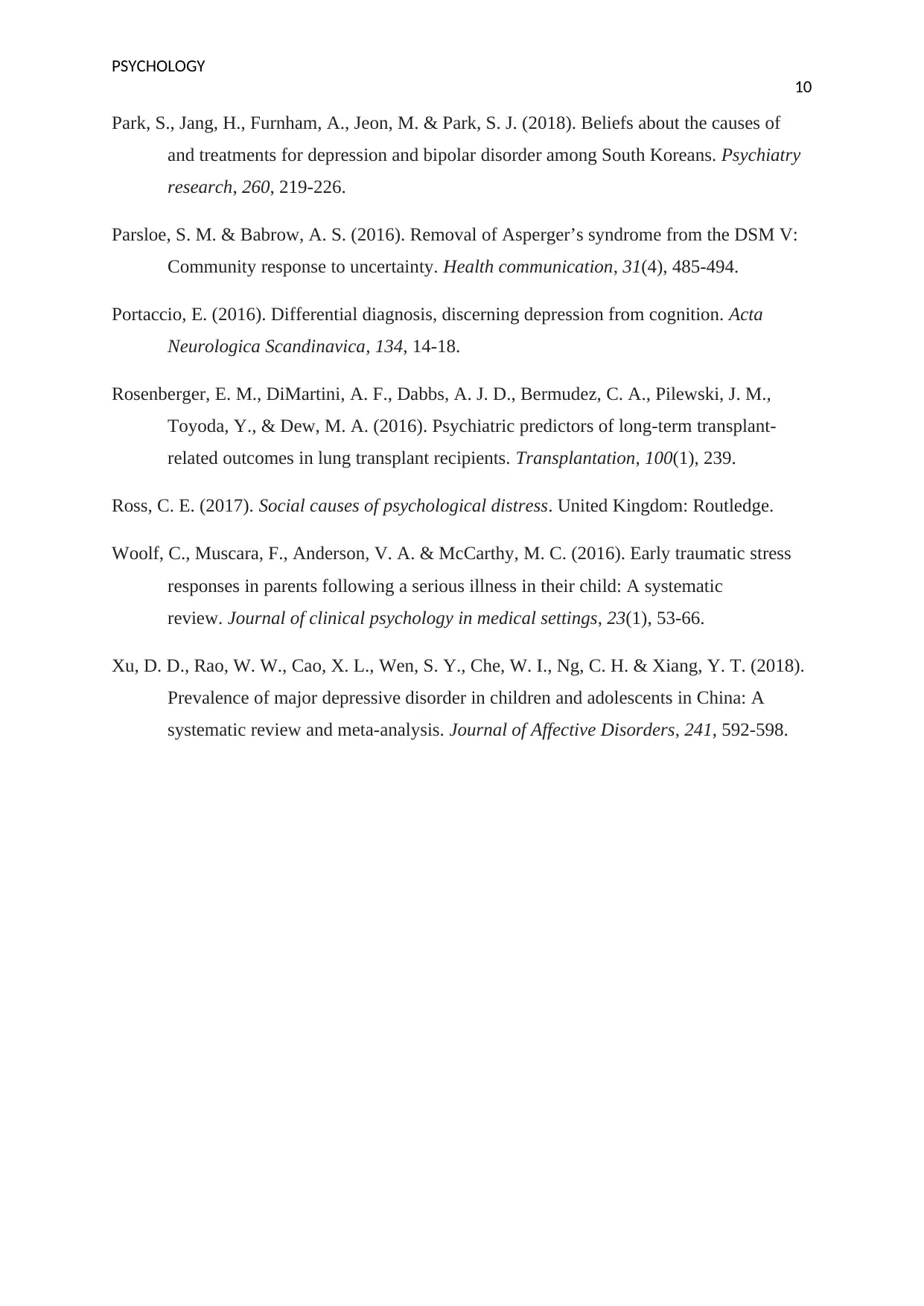
PSYCHOLOGY
10
Park, S., Jang, H., Furnham, A., Jeon, M. & Park, S. J. (2018). Beliefs about the causes of
and treatments for depression and bipolar disorder among South Koreans. Psychiatry
research, 260, 219-226.
Parsloe, S. M. & Babrow, A. S. (2016). Removal of Asperger’s syndrome from the DSM V:
Community response to uncertainty. Health communication, 31(4), 485-494.
Portaccio, E. (2016). Differential diagnosis, discerning depression from cognition. Acta
Neurologica Scandinavica, 134, 14-18.
Rosenberger, E. M., DiMartini, A. F., Dabbs, A. J. D., Bermudez, C. A., Pilewski, J. M.,
Toyoda, Y., & Dew, M. A. (2016). Psychiatric predictors of long-term transplant-
related outcomes in lung transplant recipients. Transplantation, 100(1), 239.
Ross, C. E. (2017). Social causes of psychological distress. United Kingdom: Routledge.
Woolf, C., Muscara, F., Anderson, V. A. & McCarthy, M. C. (2016). Early traumatic stress
responses in parents following a serious illness in their child: A systematic
review. Journal of clinical psychology in medical settings, 23(1), 53-66.
Xu, D. D., Rao, W. W., Cao, X. L., Wen, S. Y., Che, W. I., Ng, C. H. & Xiang, Y. T. (2018).
Prevalence of major depressive disorder in children and adolescents in China: A
systematic review and meta-analysis. Journal of Affective Disorders, 241, 592-598.
10
Park, S., Jang, H., Furnham, A., Jeon, M. & Park, S. J. (2018). Beliefs about the causes of
and treatments for depression and bipolar disorder among South Koreans. Psychiatry
research, 260, 219-226.
Parsloe, S. M. & Babrow, A. S. (2016). Removal of Asperger’s syndrome from the DSM V:
Community response to uncertainty. Health communication, 31(4), 485-494.
Portaccio, E. (2016). Differential diagnosis, discerning depression from cognition. Acta
Neurologica Scandinavica, 134, 14-18.
Rosenberger, E. M., DiMartini, A. F., Dabbs, A. J. D., Bermudez, C. A., Pilewski, J. M.,
Toyoda, Y., & Dew, M. A. (2016). Psychiatric predictors of long-term transplant-
related outcomes in lung transplant recipients. Transplantation, 100(1), 239.
Ross, C. E. (2017). Social causes of psychological distress. United Kingdom: Routledge.
Woolf, C., Muscara, F., Anderson, V. A. & McCarthy, M. C. (2016). Early traumatic stress
responses in parents following a serious illness in their child: A systematic
review. Journal of clinical psychology in medical settings, 23(1), 53-66.
Xu, D. D., Rao, W. W., Cao, X. L., Wen, S. Y., Che, W. I., Ng, C. H. & Xiang, Y. T. (2018).
Prevalence of major depressive disorder in children and adolescents in China: A
systematic review and meta-analysis. Journal of Affective Disorders, 241, 592-598.
1 out of 11
Related Documents
Your All-in-One AI-Powered Toolkit for Academic Success.
+13062052269
info@desklib.com
Available 24*7 on WhatsApp / Email
![[object Object]](/_next/static/media/star-bottom.7253800d.svg)
Unlock your academic potential
© 2024 | Zucol Services PVT LTD | All rights reserved.





